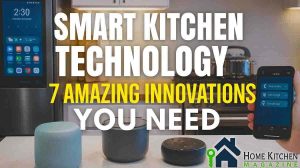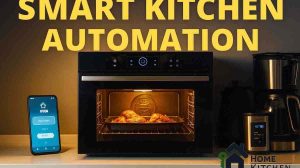It starts with the faint hum of a coffee maker that knows your morning mood. The lights softly illuminate as the aroma of freshly brewed coffee fills the air. The refrigerator screen flashes a reminder — “You’re low on milk.” With one tap, an order is placed automatically. Welcome to the era of Smart Home Kitchen Integration, where technology doesn’t just make life easier — it redefines how we live, cook, and connect.
In modern homes, the kitchen has evolved beyond a place to prepare meals; it’s the heart of daily life. It’s where conversations begin, ideas spark, and memories are made — all now powered by smart devices working in harmony. From voice-activated appliances to AI-powered meal planning, the future kitchen isn’t a dream anymore — it’s already here, quietly revolutionizing homes worldwide.
The Rise of the Smart Kitchen: A Global Movement
According to Statista, the global smart kitchen market is projected to surpass $60 billion by 2030, growing at an impressive 18% CAGR. This surge reflects a new reality — people are investing not just in luxury but in efficiency, sustainability, and personalized convenience.
The demand for smart appliances, including connected ovens, refrigerators, and dishwashers, has skyrocketed, driven by the rise of smart home ecosystems like Google Home, Amazon Alexa, and Apple HomeKit. Consumers are no longer buying single gadgets; they’re building interconnected systems — a fully integrated kitchen that anticipates needs, manages energy, and even reduces food waste.
The trend also aligns with a growing awareness of sustainability. Energy-efficient devices and intelligent cooking systems help reduce electricity and water consumption, proving that Smart Home Kitchen Integration isn’t just about luxury — it’s about living smarter and greener.
According to a detailed market study by Grand View Research, the global smart kitchen appliances market was valued at USD 18.75 billion in 2023 and is projected to grow to USD 60.20 billion by 2030, with a CAGR of 17.9%. This rapid expansion proves that Smart Home Kitchen Integration is becoming an essential part of modern living, driving innovations that combine convenience, energy efficiency, and sustainability in every home.
The Power of Integration: When Technology Meets Culinary Art
What makes a kitchen smart isn’t the number of devices — it’s the seamless integration between them. Imagine this scenario: you’re planning dinner. You ask your smart assistant for recipes based on what’s in your fridge. It scans your ingredients, suggests a few options, preheats the oven automatically, and adjusts the lighting for a warm, dinner-ready ambiance.
That’s Smart Home Kitchen Integration at its finest — a symphony of technology where everything works together. The concept focuses on synchronizing appliances, sensors, and AI systems to create a frictionless cooking experience.
Some examples include:
- Smart refrigerators that track expiration dates and recommend recipes.
- AI-driven ovens that automatically adjust temperature based on what’s cooking.
- Voice-controlled lighting to set the mood.
- Smart dishwashers that detect water hardness and optimize cycles.
This integration creates a kitchen that feels almost alive — intuitive, efficient, and responsive.
Data-Driven Kitchens: How AI and IoT Are Changing the Game
The secret behind this revolution lies in AI (Artificial Intelligence) and IoT (Internet of Things). These two technologies form the backbone of the Smart Home Kitchen Integration movement.
- AI learns your habits — when you cook, what you eat, and how you prefer your meals prepared. Over time, it predicts what you might need, helping plan your grocery list and avoid waste.
- IoT connects all your devices into a single ecosystem, enabling them to “talk” to each other.
For instance, Samsung’s Family Hub Refrigerator syncs with your phone and oven. If you scan a barcode from your groceries, the system updates your food inventory and expiration dates. It can even send a reminder if your vegetables are about to go bad.
Meanwhile, LG’s ThinQ platform takes personalization a step further by analyzing cooking patterns and suggesting maintenance schedules for your devices. It’s data-driven living — intelligent, adaptive, and effortless.
7 Powerful Upgrades That Transform Cooking Forever
Let’s explore seven real-world smart kitchen upgrades that can redefine your daily routine — each combining technology, creativity, and convenience.
1. Smart Refrigerators with Food Recognition
Modern refrigerators like the LG InstaView or Samsung Family Hub now come with internal cameras and AI recognition. They track what’s inside, alert you about expiration dates, and even suggest recipes based on what you have left.
💡 Pro Tip: Use this system to reduce food waste — the average household wastes 30–40% of groceries annually (U.S. Department of Agriculture).
2. Voice-Activated Cooking Assistants
Imagine preparing dinner while your hands are full, and you need to set a timer. With voice-activated devices like Amazon Echo Show or Google Nest Hub, you can control multiple appliances with simple commands.
These devices also integrate with recipe platforms like Yummly or Tasty, offering step-by-step cooking guidance — making even beginners feel like professional chefs.
3. Smart Ovens with AI Cooking Precision
Traditional ovens guess; smart ovens know. Models like June Oven or Bosch Series 8 use AI cameras to recognize food and automatically select the perfect temperature and cooking time.
This precision not only prevents burnt meals but also saves up to 20% of energy consumption, according to Energy Star efficiency reports.
4. Automated Coffee Machines and Beverage Systems
Morning routines are being transformed by Wi-Fi-connected coffee makers. Imagine your coffee starting to brew the moment your alarm goes off. Devices like Smarter Coffee 2nd Gen or Behmor Connected Brewer let you personalize temperature, brew strength, and timing — directly from your phone.
5. Smart Dishwashers for Sustainability
Eco-friendly doesn’t mean less powerful. Modern smart dishwashers optimize water flow, detect load size, and use sensors to determine the exact cleaning cycle required. Bosch’s Home Connect series, for example, can reduce water usage by up to 40% per cycle.
6. Intelligent Lighting and Climate Control
Lighting is part of mood and energy efficiency. Smart lighting systems like Philips Hue or LIFX can sync with your schedule — turning warm in the evening and bright in the morning. Combined with smart thermostats like Nest, you can reduce energy bills by up to 15–20% yearly.
7. Centralized Control Panels and Apps
The true power of Smart Home Kitchen Integration lies in centralized control. Platforms like Home Assistant, Apple Home, and Samsung SmartThings allow homeowners to manage everything from one app — ovens, fridges, lighting, and even air quality sensors.
It’s like having a digital butler ensuring your kitchen runs smoothly 24/7.
For a deeper look at the specific gadgets that drive true smart kitchens—from AI ovens to voice-controlled refrigerators—check out our companion article on “Smart Kitchen Technology: 7 Amazing Innovations You Need.
Real-World Benefits: Why Homeowners Are Making the Switch
Time Efficiency
The average person spends 6 hours per week in the kitchen. With automation, that number can drop significantly — allowing you to focus on family or relaxation while your kitchen handles the details.
Energy Savings
Smart appliances are designed with energy optimization in mind. For example, GE’s smart dishwashers automatically adjust water usage based on sensor readings, cutting utility bills by an average of $60 annually per household.
Healthier Living
With integrated nutrition apps, smart kitchens help you maintain dietary goals. Some systems analyze ingredients and track calorie intake, aligning with fitness apps like Fitbit or MyFitnessPal.
Sustainability
Sustainability isn’t just a buzzword — it’s a necessity. Smart systems that manage waste, track resources, and regulate power usage help minimize environmental impact. A connected kitchen can reduce household carbon emissions by up to 25%, according to data from the International Energy Agency.
If you’re looking to choose your first smart appliance and build out your kitchen integration step by step, our detailed guide “10 Best Smart Kitchen Appliances To Upgrade Your Cooking Game” is a helpful next read.
Overcoming the Challenges of Smart Integration
While the advantages are undeniable, homeowners must navigate challenges such as compatibility, data privacy, and upfront cost.
- Compatibility: Not all smart appliances communicate with every ecosystem. Choosing devices that support open standards like Matter or Zigbee ensures long-term flexibility.
- Data Privacy: Since connected devices often gather usage data, ensure you use secure networks and enable two-factor authentication.
- Initial Investment: Smart kitchen setups may seem costly initially, but long-term savings from energy efficiency and durability make them a worthy investment.
The Future of Smart Home Kitchen Integration
The next phase of evolution goes beyond automation — it’s about anticipation. Soon, your kitchen won’t just follow commands; it will predict your needs.
Emerging technologies like machine learning and edge computing will allow appliances to process data locally, making decisions instantly and securely. Imagine a fridge that recognizes your dietary preferences, syncs with your fitness app, and adjusts meal suggestions based on your health goals.
Additionally, robotic kitchen assistants — like Moley Robotics’ automated kitchen — are already capable of cooking hundreds of dishes without human intervention. The future promises a seamless blend of AI, robotics, and human creativity.
How to Start Building Your Smart Kitchen
Ready to begin your journey toward a smarter home? Start small, then expand.
Step 1: Begin with the Essentials
Invest in one or two smart appliances — a smart plug, light system, or voice assistant. Build comfort and familiarity first.
Step 2: Choose a Central Ecosystem
Decide whether to go with Google Home, Amazon Alexa, or Apple HomeKit. This helps unify your devices and reduce compatibility issues.
Step 3: Upgrade Strategically
Focus on high-impact upgrades like smart ovens, lighting systems, and refrigerators — appliances you use daily.
Step 4: Optimize Energy and Security
Use energy-saving modes, set automation schedules, and secure your network.
Step 5: Embrace Continuous Learning
Smart technology evolves rapidly. Regularly update firmware and explore new integrations to keep your kitchen efficient and safe.
Emotional Connection: When Technology Feels Human
Beneath the circuits and sensors, something profound is happening — technology is making kitchens more human. By freeing us from repetitive tasks, Smart Home Kitchen Integration allows us to rediscover the joy of cooking, the pleasure of family meals, and the satisfaction of a well-organized space.
When your kitchen listens, learns, and responds — it’s not just smart; it’s personal. It’s the silent partner in your daily rhythm, understanding your habits and helping you live better.
Bottom Line: The Kitchen of Tomorrow Starts Today
The modern kitchen is no longer just a room — it’s an intelligent ecosystem designed to nurture efficiency, creativity, and sustainability. With Smart Home Kitchen Integration, your space becomes more than functional; it becomes transformative.
Whether it’s saving energy, reducing waste, or simply brewing your perfect cup of coffee, the goal is simple: to make life smoother, smarter, and more meaningful. The future isn’t coming — it’s already cooking.




 Home Kitchen Magazine is a blog dedicated to giving you inspiration and tips every day about the home, kitchen and garden.
Home Kitchen Magazine is a blog dedicated to giving you inspiration and tips every day about the home, kitchen and garden.

